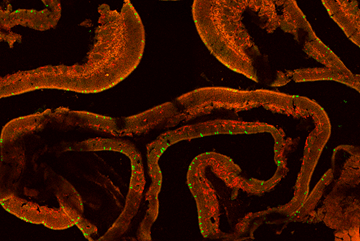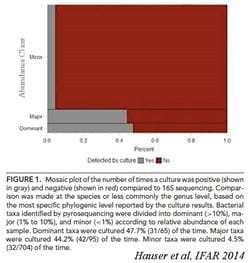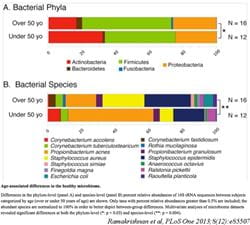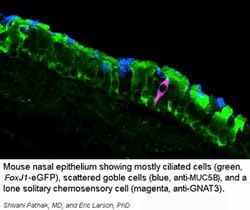Psaltis AJ, Mackenzie BW, Cope EK, Ramakrishnan VR. Unravelling the role of the microbiome in chronic rhinosinusitis. J Allergy Clin Immunol. 2022 Mar 14:S0091-6749(22)00291-3. doi: 10.1016/j.jaci.2022.02.022. Epub ahead of print. PMID: 35300985.
Frank DN, Qiu Y, Cao Y, Zhang S, Lu L, Kofonow JM, Robertson CE, Liu Y, Wang H, Levens CL, Kuhn KA, Song J, Ramakrishnan VR, Lu SL. A dysbiotic microbiome promotes head and neck squamous cell carcinoma. Oncogene. 2022 Feb;41(9):1269-1280. doi: 10.1038/s41388-021-02137-1. Epub 2022 Jan 28. PMID: 35087236; PMCID: PMC8882136.
Diaz del Valle, Fernando; Zakrajsek, Jonathan; Min, Sung-Joon; Koff, Patricia; Bell, Harold; Kincaid, Keegan; Frank, Daniel; Ramakrishnan, Vijay; Ghosh, Moumita; Vandivier, Richard. Impact of Airline Secondhand Tobacco Smoke Exposure on Respiratory Health and Lung Function Decades after Exposure Cessation. Accepted for publication in CHEST. Published:March 06, 2022 DOI: https://doi.org/10.1016/j.chest.2022.02.049
Terella AM, Mariner P, Cool CD, Ramakrishnan VR. Use of a novel Chinchilla skull base repair model to test a photo-initiated thiol-ene biopolymer. Int Forum Allergy Rhinol. 2022 Mar 28. doi: 10.1002/alr.23004. Epub ahead of print. PMID: 35344275.
Gill AS, Beswick DM, Mace JC, et al. Evaluating Distance Bias in Chronic Rhinosinusitis Outcomes. JAMA Otolaryngol Head Neck Surg. Published online May 05, 2022. doi:10.1001/jamaoto.2022.0268
Ramakrishnan VR, Larson E, Holt J, Frank DN. Infection and inflammation in chronic rhinosinusitis: Gene ontology/pathway analysis perspective. Int Forum Allergy Rhinol. 2022 Jul 13. doi: 10.1002/alr.23052. Epub ahead of print. PMID: 35829680.
Asokan A, Mace JC, Rice JD, Smith TL, Soler ZM, Ramakrishnan VR. Sex Differences in Presentation and Surgical Outcomes From a Prospective Multicenter Chronic Rhinosinusitis Study. Otolaryngol Head Neck Surg. 2022 May 31:1945998221102810. doi: 10.1177/01945998221102810. Epub ahead of print. PMID: 35639480.
Beswick DM, Humphries SM, Miller JE, Balkissoon CD, Khatiwada A, Vladar EK, Ramakrishnan VR, Lynch DA, Taylor-Cousar JL. Objective and patient-based measures of chronic rhinosinusitis in people with cystic fibrosis treated with highly effective modulator therapy. Int Forum Allergy Rhinol. 2022 May 20. doi: 10.1002/alr.23016. Epub ahead of print. PMID: 35595546.
Massey CJ, Ramos L, Beswick DM, Ramakrishnan VR, Humphries SM. Clinical Validation and Extension of an Automated, Deep Learning–Based Algorithm for Quantitative Sinus CT Analysis. Am J Neuroradiol 2022;43(9):1318-1324.
Schlosser RJ, Soler ZM, Mace J, Farrell N, Rimmer R, Alt JA, Ramakrishnan VR, Edwards TS, Smith TL. Profiles of Odorant Specific Performance in Olfactory Testing. Am J Rhinol Allergy. 2023 Jan;37(1):26-34. doi: 10.1177/19458924221124692. Epub 2022 Sep 6. PMID: 36069003.
Pandrangi VC, Mace JC, Kim JH, Geltzeiler M, Detwiller KY, Soler ZM, Schlosser RJ, Alt JA, Ramakrishnan VR, Mattos JL, Smith TL. Work productivity and activity impairment in patients with chronic rhinosinusitis undergoing endoscopic sinus surgery-A prospective, multi-institutional study. Int Forum Allergy Rhinol. 2023 Mar;13(3):216-229. doi: 10.1002/alr.23070. Epub 2022 Aug 23. PMID: 35938699; PMCID: PMC9905326.
Ramakrishnan VR, Larson E, Holt J, Frank DN. Infection and inflammation in chronic rhinosinusitis: Gene ontology/pathway analysis perspective. Int Forum Allergy Rhinol. 2022 Dec;12(12):1566-1569. doi: 10.1002/alr.23052. Epub 2022 Aug 16. PMID: 35829680; PMCID: PMC9712154.
Bubak AN, Merle L, Niemeyer CS, Baxter BD, Gentile Polese A, Ramakrishnan V, Gomez J, Madrigal L, Villegas-Lanau A, Lopera F, Macklin W, Frietze S, Nagel MA, Restrepo D. Signatures for viral infection and inflammation in the proximal olfactory system in familial Alzheimer's disease. Neurobiol Aging. 2023 Mar;123:75-82. doi: 10.1016/j.neurobiolaging.2022.12.004. Epub 2022 Dec 13. PMID: 36638683; PMCID: PMC9889108.
 The laboratory of Vijay Ramakrishnan, MD at Indiana University School of Medicine focuses on airway inflammation in chronic rhinosinusitis. Ramakrishnan received his MD from Baylor College of Medicine and completed a residency in Otolaryngology at the University of Colorado. After Rhinology Fellowship at the University of Pennsylvania, he worked as Otolaryngology faculty at the University of Colorado for twelve years, as a surgeon-scientist in the Rhinology Division. While maintaining a busy clinical practice building the Endoscopic Skull Base Program, he completed a NIH K23 award in nasal chemosensation for additional translational research training. He then moved to IU School of Medicine in January 2022 as Professor of Otolaryngology—Head and Neck Surgery and Director of Rhinology Research. Dr. Ramakrishnan is also an Affiliate Scientist in Health Services Research at Regenstreif Institute, Inc, and member of the Stark Neurosciences Research institute.
The laboratory of Vijay Ramakrishnan, MD at Indiana University School of Medicine focuses on airway inflammation in chronic rhinosinusitis. Ramakrishnan received his MD from Baylor College of Medicine and completed a residency in Otolaryngology at the University of Colorado. After Rhinology Fellowship at the University of Pennsylvania, he worked as Otolaryngology faculty at the University of Colorado for twelve years, as a surgeon-scientist in the Rhinology Division. While maintaining a busy clinical practice building the Endoscopic Skull Base Program, he completed a NIH K23 award in nasal chemosensation for additional translational research training. He then moved to IU School of Medicine in January 2022 as Professor of Otolaryngology—Head and Neck Surgery and Director of Rhinology Research. Dr. Ramakrishnan is also an Affiliate Scientist in Health Services Research at Regenstreif Institute, Inc, and member of the Stark Neurosciences Research institute. The laboratory of Vijay Ramakrishnan, MD at Indiana University School of Medicine focuses on airway inflammation in chronic rhinosinusitis. Ramakrishnan received his MD from Baylor College of Medicine and completed a residency in Otolaryngology at the University of Colorado. After Rhinology Fellowship at the University of Pennsylvania, he worked as Otolaryngology faculty at the University of Colorado for twelve years, as a surgeon-scientist in the Rhinology Division. While maintaining a busy clinical practice building the Endoscopic Skull Base Program, he completed a NIH K23 award in nasal chemosensation for additional translational research training. He then moved to IU School of Medicine in January 2022 as Professor of Otolaryngology—Head and Neck Surgery and Director of Rhinology Research. Dr. Ramakrishnan is also an Affiliate Scientist in Health Services Research at Regenstreif Institute, Inc, and member of the Stark Neurosciences Research institute.
The laboratory of Vijay Ramakrishnan, MD at Indiana University School of Medicine focuses on airway inflammation in chronic rhinosinusitis. Ramakrishnan received his MD from Baylor College of Medicine and completed a residency in Otolaryngology at the University of Colorado. After Rhinology Fellowship at the University of Pennsylvania, he worked as Otolaryngology faculty at the University of Colorado for twelve years, as a surgeon-scientist in the Rhinology Division. While maintaining a busy clinical practice building the Endoscopic Skull Base Program, he completed a NIH K23 award in nasal chemosensation for additional translational research training. He then moved to IU School of Medicine in January 2022 as Professor of Otolaryngology—Head and Neck Surgery and Director of Rhinology Research. Dr. Ramakrishnan is also an Affiliate Scientist in Health Services Research at Regenstreif Institute, Inc, and member of the Stark Neurosciences Research institute.





